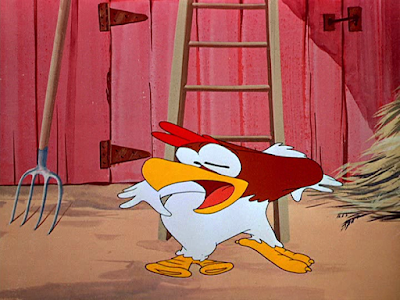Here’s Foggy not paying attention as he’s flapping his gums in The Foghorn Leghorn (1948). The dog gets the worst of it.



Foggy finally notices the dog. Here are some frames from the take.




Foghorn tries to escape from the angry dog. Check out the smear drawings as Foggy looks around before climbing the ladder.







There’s a lot of animation at the bottom of the ladder, too, as the rooster’s legs keep slipping off the rung. You sure didn’t see any action like that by the late ‘50s.
Read Devon Baxter’s research on this particular cartoon here.

Avery and Clampett took reaction shots and the depiction of character dimensions about as far as they could go, while Jones mined the perceived reality of the characters, the roles they could then enact like "real" performers, and the ability of the animator to impose rules and alter their literal reality. McKimson, certainly the best draftsman of them all, was - if not as cerebral or surreal - certainly muscular and explosive. Sometimes I wonder if he was explicitly working to expand the screen itself, taking the 2D theatrical style presentation that predominated and pushing outward, towards the audience. His cartoons of the post-WWII era seem to be coming right at you! The incredibly broad movement of hands,heads,arms and what-have-you - and so much of it literally aimed more or less "outward," give his toons an instantly recognizable style that seems to be anticipating the 3D craze to come...
ReplyDeleteAlthough Manny Gould, Phil De Lara and Fred Abranz (who did Foghorn's big "take"), all contributed to the forced perspective shots in this cartoon, Cornett Wood who did layout, also loved exaggerated perspective and loved to do distorted backgrounds. I took some art classes from him in 1969, and he still remembered the McKimson cartoons with fondness.
ReplyDelete